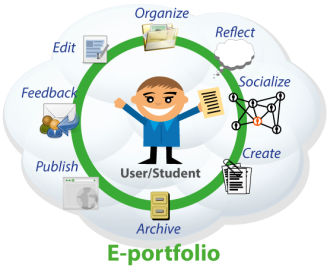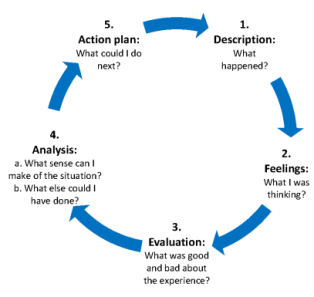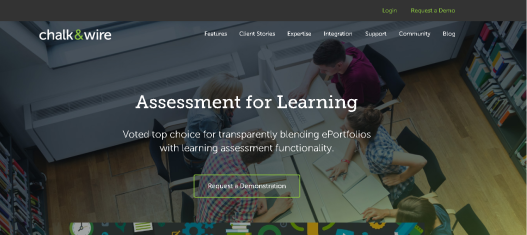E-portfolios
An E-portfolio or Electronic portfolio is a digitized collection of text, graphic and
multimedia materials which represent a person’s accomplishments, ideas and progression in a particular area for reflective, learning or career purposes (CTE – ePortfolios, 2017). E-portfolios are considered useful in the development of an individual or groups’ work as they encourage personal reflection through analysis and critique between peers or mentor and student(Educause Learning Initiative, 2017). They are also considered a useful tool when it comes to organizing and managing work produced through different applications and are far more accessible than traditional portfolios with the ability to be archived through the Worldwide Web, CD-ROM, DVD, and other electronic devices (Educause Learning Initiative, 2017).
E-portfolios enables people to record goals, achievements, work as well as learning processes. A person can then represent their information and data in different formats with a number of software and websites to serve as production tools and space(ePortfolio tools, 2017).
Some examples include (clicking on the images will direct you to the site where you can explore or set up an ePortfolio of your own):
M A H A R A
F O L I O S P A C E S
C H A L K & W I R E
F O L I O T E K
Some of these tools have different features like a resume builder, weblog and social networking systems in order to connect users and learning communities for feedback and discussion.Some of these sites offer particular features for particular purposes, take for instance FolioTek which features tools where members of an institution or organization can share, store or manage data for program accreditation targets (ePortfio tools, 2017). Stony Brook University of New York encourage the application of e-portfolios in their learning and have created a website reviewing a list of e-portfolio tools and their features.
Dr. Helen C. Barrett, a former member of the faculty of College of Education at the University of Alaska Anchorage (Barrett, 2004), dedicated her research to the implementation of e-portfolio systems since 1991 and produced a guideline to creating an e-portfolio. There are 5

stages (Barrett, 2000):
1. Setting the Portfolio Context
Despite their educational and developmental benefits, an e-portfolio’s contents can be sensitive and raises ownership and authenticity issue. There are questions of whether the contents belong to the author, the system provider or the institution the author is working under. Whether they are adequate enough to be considered an official documentation of representation is another question.Views online regarding security and privacy issues of e-portfolios have since progressed with the technology where most systems have settings that let the author control who they choose to view it (Educause Learning Initiative, 2017).
Thanks to the development of online social media and multimedia systems, students have more access to real-time step by step tutorials online as to how to create their own e-portfolio. An example below shows digital media designer, Adam Cross giving a tutorial on how students could set up an efficient e-portfolio using the WordPress blogging system:
(Cross, 2015)
Reflective Practice & Writing
Reflective practice is a skill that looks at the concept of learning from experience(Skills You Need, n.d.). This can be recorded through reflective writing whether that is journal or diary entries, narrative, or blogs as well as discussing and working on this with peers and colleagues for feedback and mentoring (What is Reflective Practice, n.d). Clinical Educator and Psychologist Neil Thompson identifies six steps in the process of reflective practice:

The final step leads back to the initial stage of description in reflective practice and so forth, therefore creating a ‘cycle’.
‘A Short Guide to Reflective Writing’ (2015) informs that reflective writing does not necessarily mean just describing what has happened nor does it mean documenting your thoughts and feelings without structure. Reflective writing should exhibit:
- A clear line of thought
- use of evidence and examples showcasing your reflections
- an analytical approach (A Short Guide, 2015)
This means establishing a balance between your personal thoughts and experience with the criteria for academic practice and analytical thinking. To show this you must:
- develop a perspective, or line of reasoning
- demonstrate that you understand the relevant readings to your topic by explaining how and why it is crucial to your own development
- write about your experiences/practice and how this links to your readings
- writing in the appropriate style (A Short Guide, 2015)
Reflective practice and writing encourages a person to make the conscious effort to not just casually consider their experiences but to assess these with a conscious effort for personal developmental purposes. Such critical analysis helps build new ideas and information on existing knowledge by refocusing your thinking on these (Zalipour, 2015). Attaining such a skill could prove useful in the future for work, home, or study settings (Skills You Need, n.d.).
References:
CTE – ePortfolios. (2016). Cornell University. Retrieved 16 March 2017, from https://www.cte.cornell.edu/teaching-ideas/teaching-with-technology/eportfolios.html
Educause Learning Initiative. (2005). George Lorenzo, John Ittelson. Retrieved from https://net.educause.edu/ir/library/pdf/eli3001.pdf
ePortfolio Tools. (n.d.). ePortfolio Review. Retrieved 6 March 2017, from https://eportfolioreview.wordpress.com/eportfolio-list/
Cross, A. (2015, October 11). Setting Up Student E-Portfolio in WordPress Blogs [Video file]. Retrieved from https://www.youtube.com/watch?v=Mw8M2Gf4Nb4
.Barrett, H. (2004). My Vitae. Retrieved 16 March 2017, from http://e-portfolios.tripod.com/id7.html
Barrett, H (2000). How to Create Your Own E- portfolio. Retreived 16 March 2017, from http://electronicportfolios.org/portfolios/howto/
Reflective Practice | SkillsYouNeed. (n.d.). Skillsyouneed.com. Retrieved 16 March 2017, from https://www.skillsyouneed.com/ps/reflective-practice.html
What is reflective practice and how do I do it?. (n.d.). Chartered Society of Physio Therapy. Retrieved 16 March 2017, from http://www.csp.org.uk/faqs/cpd/what-reflective-practice-how-do-i-do-it
Zalipour, A. (2015) Reflective Practice. Retrieved from http://www.waikato.ac.nz/tdu/pdf/Booklets/2015/ReflectPrac.pdf
A Short Guide to Reflective Writing. (2015). Birmingham. Retrieved from https://intranet.birmingham.ac.uk/as/libraryservices/library/skills/asc/documents/public/Short-Guide-Reflective-Writing.pdf
Image sources:
Faraque, S. (2013). E-Portfolio system with Mahara for International Schools. Technology Tab. Retrieved 13 March 2017, from https://tektab.com/2013/10/10/e-portfolio-system-with-mahara-for-international-schools/
Zalipour, A. (2015) Reflective Practice. Retrieved from http://www.waikato.ac.nz/tdu/pdf/Booklets/2015/ReflectPrac.pdf




Hi Teresa,
Your explanation of e-portfolios, reflective writing and practices is easy to understand. I liked how you included other websites that is focused on keeping an e-portfolio. It was a nice touch, you had a good balance in this page, where I wasn’t overwhelmed with reading too much and good idea using of images of other e-portfolio websites.
This has helped me understand more about e-portfolios, reflective writing and practicing more. Well done.
LikeLike
Thank you Elisabeth, I really tried to take Karen’s advice in making sure to not overwhelm the user with too much print and incorporate all the web elements has advised in our handbook. Cheers
LikeLike